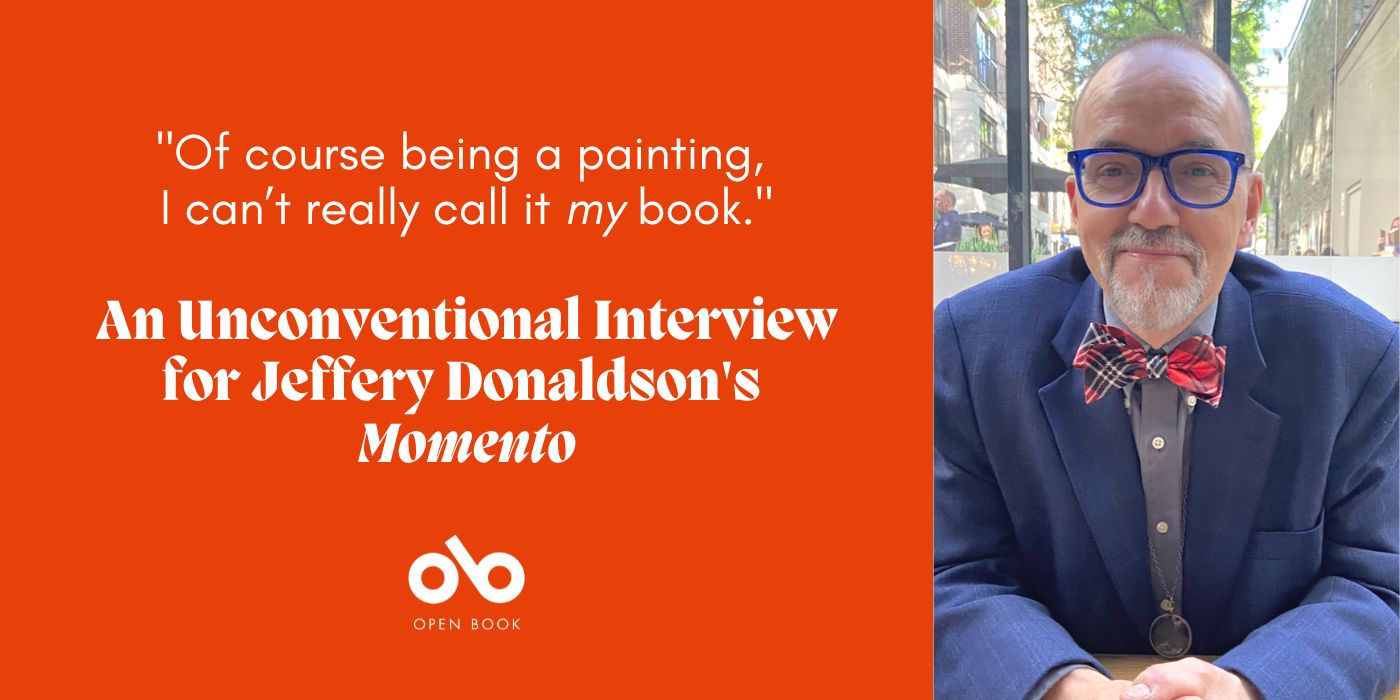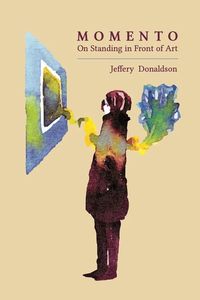An Unconventional Interview: The Paintings of Jeffery Donaldson's Ode to Art Galleries, Momento, Speak Out
A plain white room with some squares hanging on the walls fills with people, many of whom stay and stare. Maybe some are even weeping, or laughing, or huddled in deep discussion about what they see. An art gallery – that strange space that is both intensely personal and individual and yet deeply public, where people engage with art in all different ways, bringing personal context and experience to bear on what they see.
Jeffery Donaldson's Momento (forthcoming from Gordon Hill Press) is an exploration of how and why we connect with galleries and museums – why we engage in the objectively strange act of standing still in a shared space to look at something and be moved. A fluid, meditative journey, Momento is about the indefinable: the feeling and journey of experiencing art and how its very subjectivity contains its magic.
Drawing on Donaldson's background as a poet, Momento creates a kind of dreamscape that feels not unlike traversing a gallery of pages and thoughts, with Donaldson's lyrical and poignant observations standing in as paintings and sculptures.
In the vein of the book—a love letter to art and what it provides us—Donaldson has given a cheeky spin to our True Story interview series, responding not in his authorial voice but from the point of view of one of the paintings that inspired Momento. Read on to hear from an anthropomorphized work of art, discussing from its perspective on the why and how of the human-art dynamic.
Open Book:
Tell us about your new book and how it came to be. What made you passionate about the subject matter you're exploring?
A Painting, speaking for Jeffery Donaldson:
Kind of you to put it that way. Of course being a painting, I can’t really call it my book. I’m no more responsible for it than any of the other works you see here in the gallery, but as you’re standing in front of me—oh my, those tv lights are awfully bright aren’t they—I suppose I might try to cast us… in the best light. Do you like my frame? I like to think it brings out my blues and yellows. But where was I? Ah yes, Donaldson’s Momento: On Standing in Front of Art. Yes, well, I suppose he has spent rather a lot of time wandering around in here. Some of us find him a little annoying. Back and forth, back and forth. He actually carries his own stool, and get this, a magnifying glass! Can he spell pretentious? But he also carries this notebook around with him and sometimes goes off to a corner to sit and scribble. Heaven help us, I guess these are the results.
Open Book:
Is there a question that is central to your book? And if so, is it the same question you were thinking about when you started writing or did it change during the writing process?
Painting:
I'll say this much for him. He spends a lot of time thinking about what it is like, what it actually feels like, to stand in front of me. Just to stand and look. I suppose I ought to be flattered. Or at least grateful. You see, we get a lot of people through here and most of the time they can seem a little… out of place, is that the word? Their way of looking strikes us as, I don’t know, sometimes awkward, sometimes indifferent, or distracted? Like they don’t feel themselves. Heck I haven’t felt myself since I was painted, but then I don’t have to wander around in a gallery do I! Anyway, I'm not sure they really see us. We sometimes wonder whether they aren't standing on a conveyor belt that just moves them around the room at a very slow pace. They stop, they look at the print on the wall beside us, then they move on. Hey lady, what am I, chopped liver? I know, it can be hard. It's not like we're good at conversation! I once heard a fella say, out loud, “A bit reticient aren’t we?” He was wearing a bow tie; I just rolled my eyes. But ya, you have to bring your way of looking to us, or you'll miss what we are. So Donaldson tries to do more thinking about what it is actually like to be them, the visitors, looking at us. He daydreams about how many different moods one can bring from… what do you folks call it, the real world? And how many different states of mind one can feel, standing in front of a painting: slow or hurried, distracted or focused. And he tries to imagine all the different things that that moment is like. Who knows, it might amuse a few folks.
Open Book:
What do you love about writing nonfiction? What are some of the strengths of the genre, in your opinion?
Painting:
That’s an interesting question. We paintings don’t show up in fiction itself a whole bunch. But we do have our moments! Oscar Wilde’s Portrait of Dorian Gray? Rather sinister mug on that one. Do you know Margaret Atwood’s “Death by Landscape?” We’re the central symbol! There’s a Lauren Harris in the other room that can recite it by heart! I do rather like the cameo we have in Proust’s In Search of Lost Time. Our effect is so powerful that someone actually dies in front a Vermeer. Donaldson actually writes about that.
Your CanLit News
Subscribe to Open Book’s newsletter to get local book events, literary content, writing tips, and more in your inbox
But I suppose you’re right, when we aren’t the whole show in art criticism, we tend to show up in works of non-fiction. That makes sense, don’t you think? Until they started navel-gazing at themselves, paintings used to be thought of representations of the observable world, pictures of the world around us. They did the work of photography for centuries, until, well, until photography came along and freed us up to do other things, like looking at ourselves looking! Art enthusiasts have become more and more sensitive to how we were always, even when we appeared to be representational, a vision of the external world, a recreation of it according to how the artist, and the culture of that artist, tended to see things. Isn’t that the puzzle of non-fiction in a nutshell? You perceive a relationship between the historical world and the kinds of conceptual or imaginative recreations of that world that point it in the direction of… well, infinite possibility! And voila! Here we are! Often it is not the objective reliability of the work but the recreative element that lies at the heart of nonfiction. Nonfiction then (look at me when I’m talking to you!) was never a painter’s version of… what would you call it, realwriting? Thinking of it so, you would lose the tension between the actual and the imaginative that you have in the term nonfiction itself. It’s the fictive element that lies in tension with its own “non.” It is rather like a friend of mine, the painting of a pipe by Rene Magritte entitled “This Is Not a Pipe.” I call him a friend, but I don’t trust him.
Open Book:
What does the term creative nonfiction mean to you?
Painting:
Well, Donaldson fashions himself a poet, so I’m not sure he is the nonfiction author we should be turning to in thinking about the real place, and the real places, of art. And well, he likes to make things up. You see, in nonfiction there is normally a certain degree of veracity that we look for. Real places, historical events. I mean, sure, we qualify: here I am, on the gallery wall, and there you are looking at me. It’s all happening for real! Of course it is a delicate balance, and visiting a gallery is a very real personal experience, but I think Donaldson goes too far. He pictures visitors who come to look at us as though they were, in a sense, the very first daub of paint on a canvas, uncertain what they will become. He thinks of gallery visitors as fictional characters in a story that they themselves are telling. Or as though they were poems writing themselves as they moved around. I ask you! And then he goes on about how one person in front of one painting is like a metaphor, two identities confronting one another, with a gap between them where energies are exchanged. I just think it’s a little bit off the map, outside the frame, if you take my drift.
Open Book:
What are you working on now?
Painting:
Funny you should ask. I’m working on something right now! There’s a certain kind of poem that Donaldson has always liked, called “Ekphrasis,” poems about works of art. No no no, he's not planning to write any more of those, thank God. But do you know where the word comes from? It’s a Greek term—εκ-φρασισ—that means “to make speak out.” Get it? Paintings are silent and poets make them talk? I thought I would steal that. So I'm planning to do this little prose piece where the ruse is—now pay attention—that I'm getting interviewed by a local news team (camera and lights and everything!), and have lots of clever things to say about what it feels like to be me, a painting! High time one of us spoke out.
________________________________________________
Jeffery Donaldson is the author of several collections of poetry including Granted: Poems of Metaphor (Fall 2022). Palilalia was nominated for the Canadian Author’s Association Award for Poetry in 2008 and a prose work, Viaticum: From Notebooks, received the Hamilton Arts Council Award for non-fiction in 2021. Donaldson teaches poetry and poetics at McMaster University. He lives in Hamilton.






